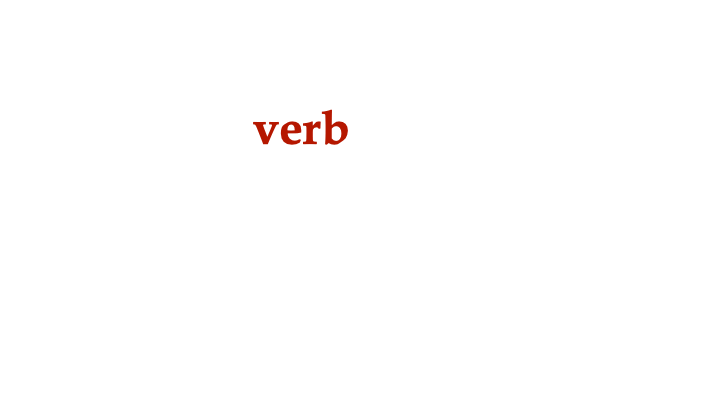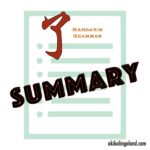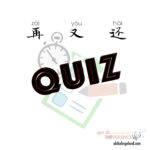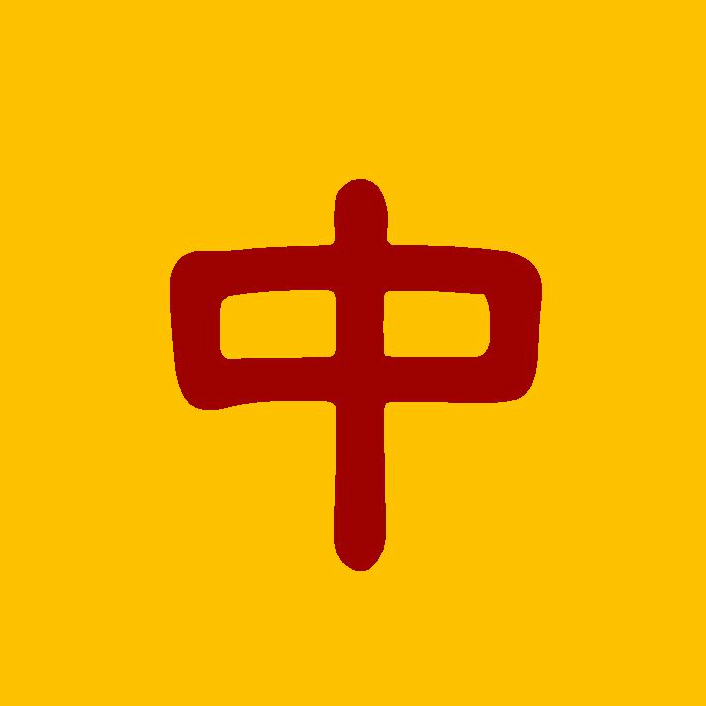When to Use 了 le
了 = past tense
If you ever hear someone tell you that, you can be quite sure that the person doesn’t understand the language at all, even if they are Chinese! Because 了 ≠ past tense!

Looks innocently simple doesn’t it! But if you have learnt Mandarin for a while, you probably feel that the more you learn 了, the more you don’t know it. Just when and how do you use it? Something that was supposed to be simple somehow became a huge entangled mess. Not to worry. We’ll untangle it one thread at a time!
This is going to be a gruelling lesson so do hold on tight! To help you revise, I’ve also created a summary and a quiz. Check them out too!
Word of caution!
In order for you to understand 了 better, or to get through this episode in fact, you have to first chuck away the English paradigm, or the paradigm of any other language with tenses. It’s hard, if that has been the only way you looked at languages, but this is a really important point, because many Mandarin learners get stuck due simply to them failing to look at Mandarin the way it is. Let’s learn Mandarin with a clean slate of mind!
Now first and foremost let’s look at a couple of short simple sentences to prove that 了 = past tense is a misconception that you should abandon once and for all.
1a)
Wǔ diǎn le.
五点了。
五点了
It’s five o’clock.
2a)
Wǒmen shì péngyou le.
我们是朋友了。
我们是朋友了
We’re friends now.
Neither means the past, even though 了 is present. How is that so? Stay tuned, we’ll come to that later!
So what is 了? There are, broadly speaking, two types of 了. The first is called an aspect particle, 动态助词 dòngtài zhùcí, usually called 了1, and the second is called a modal particle, 语气助词 yǔqì zhùcí, usually called 了2. They may look the same, but are actually different creatures.
What is an aspect particle in Mandarin, and what does it do? An aspect particle is placed after a verb, and it expresses the state of the action, and in the case of 了1, it gives us information about the completion of the action. Many people confuse this with tense, and think that completion of an action equals past tense. It is not. In English, the tense tells us whether an action is in the past, present or future, but in Mandarin, the aspect particle 了1 tells us the state of the completion of the action at a certain point in time.

This might be hard to understand, but it will get clearer as we go through the explanation and examples. In case you are wondering, other aspect particles include 过 guo and 着 zhe.
Let’s look at the traits of 了1. There are quite a lot, but the following are the more important ones, and more than enough to make you go crazy! Remember, there’s still 了2 after this! As you go through each of them, try to bear in mind the nature of 了1, which is about completion. Gradually you should be able to understand it better.
- aspect marker, not tense marker
- after verb, before object
- prone to loneliness
- once is enough
了1 is usually not used in the following cases:
- negative sentences
- habitual or repetitive actions
- when completion is of no importance
- emotional or mental verbs
- non-action verbs
- modal verbs
1. aspect marker, not tense marker
Let’s look at this sentence:
3a)
Wǒ chīle.
我吃了。
我吃了
I have eaten./ I ate.
Now you probably are thinking that this clearly is past tense. But I’m not quite done with the explanation yet! Completion of an action does not mean it is in the past. We have to think of it within the context of the sentence. Let’s look at the next one:
3b)
Wǒ chīle jiù qù shàngbān.
我吃了就去上班。
我吃了就去上班
I’ll go to work after eating.
As I said, completion does not mean it has happened. It simply means what it means – completion, and this completion could happen in the past or future. So in 3b), 了 still indicates completion of the verb 吃, but that action of eating has yet to be completed. It simply is saying that when the action of 吃 is complete, I will go to work. So in fact, in this sentence, I have not gone to work, neither am I done with eating!
2. after verb, before object
In most cases, 了1 comes after the verb and before the object.
V + 了1 + O
Let’s tweak example 3b) a little bit:
3c)
Wǒ chīle fàn jiù qù shàngbān.
我吃了饭就去上班。
我吃了饭就去上班
I’ll go to work after eating.
Here, instead of just the verb 吃, we have also the object 饭. The aspect particle 了1 comes after the verb and before the object. We don’t say:
Wǒ chī fàn le jiù qù shàngbān.
我吃饭了就去上班。
Ok, actually in spoken language you probably might hear this kind of structure from time to time, but well, it’s not very grammatical.
Note that if the verb contains a resultant complement, 结果补语 jiéguǒ bǔyǔ, 了1 comes after the complement. For example,
3d)
Wǒ chīwán le fàn jiù qù shàngbān.
我吃完了饭就去上班。
我吃完了饭就去上班
I’ll go to work after I finish eating.
3. prone to loneliness
This one needs quite a bit of explaining. Again, let’s look at example 3). Say, we have this version of it:
3e???)
Wǒ chīle fàn.
我吃了饭。
我吃了饭
I’ve eaten./ I ate.
We have 了1 after the verb and before the object, just like what we have learnt in the previous point, so it seems ok, doesn’t it? The problem is that it ends just like that. This sentence doesn’t sound quite complete, as though the speaker has yet to finish speaking.了1 likes socialising, and needs more than just an object.
Let’s look at three ways to make sure the sentence does not sound unfinished. The first is to have an attributive before the object. In simpler terms, we need to place something before the object to modify it so that it is more specific. This attributive is typically a measure word, an adjective or a pronoun.
to make sentence sound complete, method 1: V + 了1 + attributive + O
3f)
Wǒ chīle liǎng wǎn fàn.
我吃了两碗饭。
我吃了两碗饭
I ate two bowls of rice.
(measure word as attributive)
Here are more examples with different attributives:
4a)
Wǒ zuòle hěn duō mántou.
我做了很多馒头。
我做了很多馒头
I made a lot of buns.
(adjective as attributive)
5)
Mèimei chīle wǒ de píngguǒ.
妹妹吃了我的苹果。
妹妹吃了我的苹果
My younger sister ate my apple.
(pronoun as attributive)
6)
Tā mǎile hěn dà de fángzi.
他买了很大的房子。
他买了很大的房子
He bought a large house.
(adjective as attributive)
The second way to avoid sounding unfinished is having an adverbial adjunct before the verb:
to make sentence sound complete, method 2: Adverbial + V + 了1 + O
3g)
Wǒ yǐjing chīle fàn.
我已经吃了饭。
我已经吃了饭
I have already eaten.
4b)
Wǒ zuótiān zuòle mántou.
我昨天做了馒头。
我昨天做了馒头
I made buns yesterday.
If you have been paying close attention, you might have guessed the third way to avoid sounding unfinished. That’s right – by finishing the sentence with more information, like our previous sentence:
to make sentence sound complete, method 3: V + 了1 + O + 2nd clause
3c)
Wǒ chīle fàn jiù qù shàngbān.
我吃了饭就去上班。
我吃了饭就去上班
I will go to work after eating.
If we didn’t have an attributive, an adverbial, or a second clause, and left the sentence in 3e) as it is, I personally wouldn’t say the sentence is terribly wrong, but if someone said this to me, I would probably be left wondering, what exactly is the point you are trying to make, and I would be expecting more from you. It is like a sentence with only the skeleton. Having an attributive, an adverbial or a second clause fills up the noisy void, thereby making it sound complete.
So, remember that 了1 doesn’t like being alone with the object. Make sure it gets more company!
4. once is enough!
Typically, in serial verb sentences 连动句 liándòngjù and pivotal sentences 兼语句 jiānyǔjù, in which more than one verb is present, we only use 了1 with the last verb. I cannot go into details of these structures here, but they are important structures in Mandarin. If you have not learnt them, just know for now that they are structures with more than one verb, and get a rough feel of what I mean by ‘once is enough’ through the following examples. Let’s look at these examples:
7)
Wǒ zuótiān zuò dìtiě qùle tā jiā.
我昨天坐地铁去了他家。
我昨天坐地铁去了他家
I took the subway to his house yesterday.
8)
Wǒ ràng tā dǎsǎo le háizi de fángjiān.
我让他打扫了孩子的房间。
我让他打扫了孩子的房间
I asked (/let/made) him to clean up the children’s room.
Now let’s move on to look at cases when we usually don’t use 了1.
5. negative actions
In negative sentences, 没 méi is added before the verb, and 了1 has to be dropped. The negative structure is:
没(有) méi (yǒu) + V
3h)
Wǒ méi chī.
我没吃。
我没吃
I didn’t eat.
4c)
Wǒ méi zuò mántou.
我没做馒头。
我没做馒头
I didn’t make buns.
Do note that 不 bù is not used to negate 了1.
6. habitual or repetitive actions
This is where a lot of learners make mistakes. In habitual actions, even if the action is done, 了1 is unnecessary.
9)
Xiǎo shíhou, wǒ měitiān chī dòushābāo.
小时候,我每天吃豆沙包。
小时候我每天吃豆沙包
When I was young, I ate bean paste buns every day.
Even if the occurrence is rare, we don’t use 了1.
10)
Xiǎo shíhou, wǒ zhǐshì ǒu’ěr chī dòushābāo.
小时候,我只是偶尔吃豆沙包。
我只是偶尔吃豆沙包
When I was young, I ate bean paste buns only once in a while.
HOWEVER, if completion of the action is important in the context, 了1 has to be used.
11)
Xiǎo shíhou, wǒ měitiān dōu shì chīle dòushābāo zài hē kěkě.
小时候,我每天都是吃了豆沙包再喝可可。
我每天都是吃了豆沙包再喝可可
When I was young, I used to drink cocoa after having bean paste buns every day.
7. when completion is of no importance
Even if it the action has been completed, we don’t usually use 了1 if its completion is of no importance. This type of sentence is typically seen in reporting or narrating, especially consecutive actions.
12)
Tā dǎkāi mén, zǒujin chúfáng, zuòxialai jìngjìngde chī fàn.
她打开门,走进厨房,坐下来静静地吃饭。
她打开门
She opened the door, walked into the kitchen, and sat down to eat quietly.
On the other hand, if you want to emphasise completion, you can use 了1 repeatedly.
13)
A:
Nǐ jīntiān dōu zuòle xiē shénme?
你今天都做了些什么?
你今天都做了些什么
What did you do today?
B:
Xǐle yīfu, sǎole dì, mǎile cài, zuòle fàn, mángdehěn ne!
洗了衣服,扫了地,买了菜,做了饭,忙得很呢!
洗了衣服
I did the laundry, swept the floor, did the grocery and prepared dinner. Super busy!
8. emotional or mental verbs
We don’t use 了1 with emotional or mental verbs, as these verbs are about emotional and mental states, not about completion of actions.
14)
Shàng dàxué de shíhou, wǒmen dōu xǐhuan nàge gēshǒu.
上大学的时候,我们都喜欢那个歌手。
上大学的时候
We all liked that singer when we were in university.
15)
Wǒ dǎsuan jìxù xuéxí Hànyǔ.
我打算继续学习汉语。
我打算继续学习汉语
I intend to continue learning Mandarin.
9. non-action verbs
Again, verbs like 是 shì, 在 zài, 姓 xìng have nothing to do with completion, so 了1 is not used. (Note that there are exceptions, so there are cases where non-action verbs are used with 了1.)
16)
Nà shíhou tā shì lǎoshī.
那时候她是老师。
那时候她是老师
She was a teacher then.
17)
Zuótiān wǒ zài jiā.
昨天我在家。
昨天我在家
I was at home yesterday.
10. modal verbs
Modal verbs like 想 xiǎng, 要 yào, 能 néng, 会 huì, 可以 kěyǐ, express possibility, ability or willingness, not completion, so again, 了1 is not used.
18)
Wǒ gāngcái xiǎng chī liǎng wǎn fàn, kěshì tā zhǐ gěi wǒ yī wǎn.
我刚才想吃两碗饭,可是他只给我一碗。
我刚才想吃两碗饭
I wanted to eat two bowls of rice just now, but he only gave me one bowl.
19)
Nǐ xiǎo shíhou huì shuō Yīngyǔ ma?
你小时候会说英语吗?
你小时候会说英语吗
Could you speak English when you were young?
Good job for surviving so far! Now let’s move on to 了2.
As we have seen, although there are many things to bear in mind about 了1, fundamentally it only expresses one thing – the completion of an action. Similarly, 了2, despite having a variety of meanings on the surface level, has basically one most important underlying feature that you should familiarise yourself with – change. Some of the following might be baffling to a beginner, especially if you already have the “了 = past tense” mind set, so keep in mind its key function of expressing change.
First off, let’s have an overview of what we will learn about 了2:
- mostly placed at end of sentence
- indicates change
- expresses confirmation of completion of action
- expresses change in quantity
- expresses urging or advice
- fixed structures
1. mostly placed at end of sentence
This is one easy way to decide whether you are looking at 了1 or 了2. As we have already seen, 了1 is in most cases placed after the verb. 了2, on the other hand, comes mostly at the end of a sentence.
2. indicates change
This is the main characteristic of 了2. We should look at this from a broad perspective. What is meant by ‘change’? It could be that something has transformed completely into another, or just mildly modified. The change could be sudden, or gradual. A new situation has emerged, or a previous condition has disappeared. In any case, the point is that there is change. Often we can’t translate this meaning of change. But since it means that ‘the situation has become so’, often it is translated as ‘already’, ‘no longer’, or ‘now’.
Let’s go back to the two sentences at the beginning.
1a)
Wǔ diǎn le.
五点了。
五点了
It’s five o’clock.
2a)
Wǒmen shì péngyou le.
我们是朋友了。
我们是朋友了
We’re friends now.
Depending on what kind of nuance you want to convey, sentence 1a) could be translated as ‘it is already five o’clock’, and 2a) ‘we are already friends’, or, ‘we’ve become friends’.
In case you are still quite baffled, let’s compare the following:
1a)
Wǔ diǎn le.
五点了。
五点了
It’s five o’clock.
VS
1b)
Xiànzài wǔ diǎn.
现在五点。
现在五点
It’s five o’clock now.
They both basically mean the same thing. But we would probably say them under different circumstances. Say, you are busy working at your computer, and then happen to take a glance at the clock. And suddenly you realise the time. Oh, it’s five o’clock! In this case you would say 五点了 Wǔ diǎn le.
Let’s look at another scenario. You are out shopping with your friends and you all decide that you would go shop for your own stuff before gathering again. You need to fix a time, so you look at your watch and notice it’s five o’clock now. In that case, you would say 现在五点 Xiànzài wǔ diǎn, as you are simply reporting the time. And maybe you would continue with 我们六点集合吧 Wǒmen liù diǎn jíhé ba – let’s gather at six. In case you are wondering, can we combine the two variations and say:
1c)
Xiànzài wǔ diǎn le.
现在五点了。
现在五点了
It’s five o’clock now.
Yes, that works fine! There’s no hard and fast rule to this, it simply depends on what nuance is needed in that particular situation.
Let’s look at example 2a) again in greater depth.
2a)
Wǒmen shì péngyou le.
我们是朋友了。
我们是朋友了
We’re friends now.
Very often, learners make this kind of sentences, intending to mean ‘we were friends’, in the mistaken belief that 了 means past tense. Let’s look at the following to understand this better.
2b)
Wǒmen yǐqián shì péngyou. Xiànzài bù shì le.
我们以前是朋友。现在不是了。
我们以前是朋友现在不是了
We were friends before. Now we are no longer friends.
The first sentence without 了 would become past tense in English, whereas the second, with 了, is present tense. Now do you see why you should never think of 了 as past tense?
This 了2 indicating change is often placed after nouns, adjectives, verbs, modal verbs and even phrases. Verbs 有 yǒu and 是 shì are often used with this. We have seen a noun example in 1) and a 是 shì example in 2). Let’s now look at other cases.
20)
Wǒ pàng le.
我胖了。
我胖了
I’ve put on weight.
This literally means ‘I fat already’ (Singlish!). I wasn’t previously, but now I am.
21)
A:
Míngtiān de huìyì nǐ yě děi cānjiā.
明天的会议你也得参加。
明天的会议你也得参加
You also have to join the meeting tomorrow.
B:
Hǎo, zhīdào le.
好,知道了。
好知道了
Alright.
I didn’t know previously, now I know.
22)
Míngtiān xīngqī yī le.
明天星期一了。
明天星期一了
It’s Monday tomorrow.
In this example, can we say simply 明天星期一 Míngtiān xīngqī yī? Yes we can. The 了 adds on a sense of change. Imagine tearing off the page of the calendar. Without 了, you are simply stating the fact that it is Monday tomorrow.
23)
Wǒ yǒu nǚ péngyou le.
我有女朋友了。
我有女朋友了
I’ve got a girlfriend.
I previously had no girlfriend, now I’ve got one.
24)
Wǒ bù xiǎng qù le.
我不想去了。
我不想去了
I don’t feel like going anymore.
In this example, with or without 了 makes quite a bit of a difference. Having 了 here means that you previously wanted to go, but now you’ve had a change of mind. Another point to take note is, if you recall, for negatives in 了1, we can only use 没 méi, not 不 bù. For 了2, both 不 bù and 没 méi are often used, since 了2 talks about change, not about actions being completed. Also, we can’t use modal verbs for 了1, but as you can see here, we can use them with 了2.
25)
Shǒujī méi diàn le.
手机没电了。
手机没电了
The phone has run out of battery.
There was battery earlier, but not anymore.
26)
Tā nǎinai shēntǐ bù hǎo le.
他奶奶身体不好了。
他奶奶身体不好了
His grandmother’s health is failing.
His grandmother used to be better in health, but now no longer.
I have lumped examples of nouns, adjectives, verbs, modal verbs, phrases into one single section, but if you really want to learn this well, I would suggest doing lots of practice with each of them, one by one, so that you get used to the different structures and get a good feel of them. Otherwise you might end up getting confused.
3. expresses confirmation of completion of action
Actually this should also be part of point B – expressing change, but I have chosen to single it out, as this feature of 了2 is probably the most confusing.
Remember earlier we when we were looking at 了1, I said that the following sentence is a little awkward?
3e???)
Wǒ chīle fàn.
我吃了饭。
我吃了饭
I’ve eaten./ I ate.
It sounds as if the sentence is half-finished. To make it sound complete, we learnt earlier (3. prone to loneliness in 了1) that you either could insert an attributive before the object, an adverbial adjunct before the verb, or continue with a second part of the sentence. Now you have yet another way to finish it off nicely. Just add 了2 at the end.
to make sentence sound complete, method 4: V + 了1 + O + “了2”
3i)
Wǒ chīle fàn le.
我吃了饭了。
-我吃了饭了
I’ve eaten./ I ate.
That means, in this sentence, we have both 了1 and 了2. So, ironically, although 了1 is used for indicating completion, it does not complete this sentence well on its own. 了2 is the one that finishes the job! Remember I said that 了1 only expresses completion but does not necessarily mean that the action is really complete? This 了2 gives the final ’confirmation’ that the action is complete.
Actually, in such short sentences, 了1 can be, and is often, omitted. So we can simply say:
3j)
Wǒ chī fàn le.
我吃饭了。
我吃饭了
I’ve eaten./ I ate.
How do we reconcile this with the feature of change? 了2 wraps up the whole sentence before it, indicating that this is a new situation that has emerged. The new situation now is that I have eaten. In English, this sentence is past, but as I have been repeating, it does not mean past tense in Mandarin, even though it looks eerily like the past tense! It basically confirms that an action has been completed, and this is the new situation.
I know if this is the first time you are learning this, it might sound a little bizarre, and it might take a bit of time for this feature to really sink in.
Let’s look at another one of our previous eating examples.
3b)
Wǒ chīle jiù qù shàngbān.
我吃了就去上班。
我吃了就去上班
I will go to work after eating.
Let’s see what happens if we affix 了2 at the end:
3k)
Wǒ chīle jiù qù shàngbān le.
我吃了就去上班了。
我吃了就去上班了
I went to work after eating.
We have the confirmation that everything in this sentence has happened. I ate, and I went to work too. 了2 confirms that this is the new situation.
4. expresses change in quantity
Again, this is about change so it should come under point B, but because this is a huge topic, I had to single it out.
We’ll start from something simple:
27)
Háizi bā suì le.
孩子八岁了。
孩子八岁了
The child is eight years old now.
This indicates there has been change in the age, and now it has reached eight years old. This is, in fact, the same category as example 1a) we looked at:
1a)
Wǔ diǎn le.
五点了。
五点了
It’s five o’clock.
There has been ongoing change in the time, and now it has reached five o’clock.
Let’s now look at something more complex – using 了2 with the Complements of Quantity and Duration 数量补语 shùliàng bǔyǔ and 时量补语 shíliàng bǔyǔ. If you have learnt the Complements of Quantity and Duration, you might have learnt that when you have a single 了, it means the action is over, and when you have two 了s, it means that the action is ongoing.
28a)
Wǒ xuéle liǎng nián Hànyǔ.
我学了两年汉语。
我学了两年汉语
I learnt Mandarin for two years.
28b)
Wǒ xuéle liǎng nián Hànyǔ le.
我学了两年汉语了。
我学了两年汉语了
I have been learning Mandarin for two years.
These two examples are commonly found in textbooks to indicate the difference between having one 了 and two 了s. In 28a), the action of learning is complete, whereas in 28b), I am still learning and intend to continue. What is the logic behind this?
Let’s use our previous example to find out.
3f)
Wǒ chīle liǎng wǎn fàn.
我吃了两碗饭。
我吃了两碗饭
I ate two bowls of rice.
As we learnt earlier, in order to make the sentence sound complete, we need an attributive before the object, and in this case, the attributive is 两碗 liǎng wǎn. So in this sentence, I have eaten two bowls of rice, and the action of eating is complete. Now let’s see what happens if we add 了2 at the end of it.
3l)
Wǒ chīle liǎng wǎn fàn le.
我吃了两碗饭了。
我吃了两碗饭了
I have already eaten two bowls of rice.
This basically still means that I ate two bowls of rice, but the final 了2 indicates the change in the number, and this is something in progression. I ate the first bowl, and now I have reached the second. Think of this sentence like an open-ended story. In the case of 3f), the action of eating is complete, and you can assume that this is the end of the story. But in the case of 3l), the story is to be continued. This person might still want to eat yet another bowl. Or he might want to say that he can’t eat anymore. Do you now get what I meant by this is something still in progression?
Let’s compare the following three dialogues. First, with only 了1:
29a)
A:
Jīntiān lǎobǎn qǐng kè, yīdìng chī de hěn bǎo ba?
今天老板请客,一定吃得很饱吧?
今天老板请客
It was the boss’ treat today. You must have had your fill?
B:
Shì a, chāo hǎochī, wǒ chīle liǎng wǎn fàn.
是啊,超好吃,我吃了两碗饭。
是啊我吃了两碗饭
Yeah, it was super delicious. I had two bowls of rice.
Now, with both 了1 and 了2:
29b)
A:
Nǐ zhēn néng chī a!
你真能吃啊!
你真能吃啊
You sure can eat a lot!
B:
Shì a, wǒ chīle liǎng wǎn fàn le, zài chī yī wǎn yīnggāi jiù bǎo le.
是啊,我吃了两碗饭了,再吃一碗应该就饱了。
是啊我吃了两碗饭了
Yeah, I’ve already had two bowls. Another bowl and I should be full.
OR
29c)
A:
Jīntiān wǒ qǐng kè, nǐ zěnme chī de nàme shǎo? Zài duō chī xiē!
今天我请客,你怎么吃得那么少?再多吃些!
今天我请客
It’s my treat today, why are you eating so little? Have more!
B:
Bù xíng a, wǒ chī le liǎng wǎn fàn le, zài chī jiù zǒubudòng le.
不行啊,我吃了两碗饭了,再吃就走不动了。
不行啊我吃了两碗饭了
Oh I can’t. I’ve already had two bowls. I won’t be able to move if I eat more.
Let’s take a breather. You might now be quite overwhelmed by the seemingly inconsistent or even contradictory traits we have seen so far. So we learnt earlier that in order to mark an action complete, we simply put 了2 at the end (3. expresses confirmation of completion of action). Yet now we’ve just learnt that if we have 了2 at the end, it means the action is not finished?! Fret not. It’s not contradictory. This new trait that we’ve just learnt pertains to the Complements of Quantity and Duration, or, to put it in simpler terms, it is when we are talking about numbers (specifically, how many or how long). Also, abandon the baggage of ‘past tense’, bear in mind the notion of ‘change’. This should help prevent you from losing your track!
5. expresses urging or advice
You might have heard people say this:
30)
Zǒu le
走了
走了
What do you think this means? Without any context, we could guess that this might mean that someone has left (i.e., the action of leaving has happened). In that case it could be part of a dialogue like the following:
30a)
A:
Xiǎomíng ne?
小明呢?
小明呢
Where’s Xiaoming?
B:
Zǒu le.
走了。
是啊我吃了两碗饭
He’s left.
But it can also be used when urging people to leave. Often, in such cases, the speaker would say the same thing twice or more.
30b)
Zǒu le! Zǒu le!
走了!走了!
走了走了
Get going! Get going!
And why can this 了2 be used for urging people to do something? That’s because this 了2 tells us that the time has come to do something, or to stop doing something. Again, this is the fundamental trait of expressing change. It wasn’t time to leave a while ago, but now, the situation has changed and it’s time to leave.
This is a good example to look at how Mandarin is so highly dependant on context. The action of 走 zǒu could be anybody, including the speaker. It might mean that the speaker himself is leaving right now, as the subject 我 wǒ can be omitted. So here, you can imagine that the speaker is announcing that it is time for him to leave.
30c)
(Wǒ) zǒu le!
(我)走了!
我走了
I’m off!
If the subject is unspecified, as I said, the action of 走 could be referring to anybody, or even anything actually. Say, we have been waiting anxiously for the bus to move, so finally when it moves, we might say in relief:
30d)
Zǒu le, zǒu le!
走了,走了!
走了走了
It’s moving, it’s moving!
Without context, what is unclear is not just the subject, but also the time of action. The action of leaving might have been over for some time, like 30a), or is just going to happen the very next moment, like 30b) and 30c), or it could also be happening right this moment, like 30d). Are you, at this point, wondering if machine translation is ever possible?
Anyway, let’s look at a couple more examples:
31)
Bié kū le!
别哭了!
别哭了
Stop crying!
32)
Chī fàn le!
吃饭了!
吃饭了
Time for breakfast/ lunch/ dinner!
Wait… Doesn’t this last one look familiar? Yes, we saw something similar earlier in 3. expresses confirmation of completion of action, example 3j:
3j)
Wǒ chī fàn le.
我吃饭了。
我吃饭了
I’ve eaten./ I ate.
Now that we have learnt that this 了2 can also mean ‘it’s time to do (or stop doing) something’, do you see what other possible meaning this sentence could have? Right, it could mean ‘I’m going to eat now.’ Perhaps a little bit of context to make it easier to understand. Let’s look at the following dialogue:
33)
A:
Wǒ hái méi hǎo ne, nǐ děngdeng wǒ, wǒmen yīqǐ chī fàn.
我还没好呢,你等等我,我们一起吃饭。
我们一起吃饭
I’m not done yet. Wait for me, we’ll eat together.
B:
Hǎo, wǒ děng nǐ.
好,我等你。
好我等你
Ok, I’ll wait for you.
yī xiǎoshí hòu
一小时后……
An hour later…
B:
Zài děng nǐ wǒ è sǐ le, bù děng le. Wǒ chī fàn le!
再等你我饿死了,不等了。我吃饭了!
再等你我饿死了
I’ll die of hunger if I continue waiting for you. Not waiting anymore. I’m going to eat.
6. fixed structures
And then there are fixed structures with 了2, which are a lot easier since they are set forms. Here are a few most common structures.
太 tài + Adj + 了 le
Although the direct translation is ‘too ~’, it could be translated several ways, including ‘very’, ‘so’, ‘awfully’, and so on. Note that this can be used for both positive and negative contexts.
34)
Xiànzài qù de huà tài wǎn le, wǒmen míngtiān zài qù ba.
现在去的话太晚了,我们明天再去吧。
现在去的话太晚了
It’s too late to go now. Let’s go tomorrow.
35)
Nǐ zuò de mántou tài hǎochī le, wǒ zhēn xiǎng tiāntiān chī.
你做的馒头太好吃了,我真想天天吃。
你做的馒头太好吃了
The buns you make are simply delicious. I’d so much love to eat them every day.
V/Adj + 死 sǐ (O) 了 le
This is very similar to 太…… 了, except that it is a lot more colloquial and has a stronger intensity. It literally means ‘~ to death’, and can mean so, but usually, we use it just for exaggeration. Compared to 太……了, this expression mostly has negative connotations, but sometimes to express the intensity, it is also used in a positive way.
36)
Zhè háizi, wǒ shuō shénme dōu dǐng zuǐ, qì sǐ (wǒ) le!
这孩子,我说什么都顶嘴,气死(我)了!
这孩子我说什么都顶嘴
This kid talks back no matter what I say. He’ll be the death of me!
37)
Jīntiān zhōngyú kàndào ǒuxiàng, kāixīn sǐ le!
今天终于看到偶像,开心死了!
今天终于看到偶像
I finally got to see my idol today. I’m on cloud nine!
要 yào + V (O) + 了 le
This indicates that something is about to happen. Adjectives and nouns are also possible, but verbs are the most common in this structure.
38)
Yào shàngkè le, wǒmen huí jiàoshì ba.
要上课了,我们回教室吧。
要上课了我们回教室吧
Class is starting soon. Let’s go back to the classroom.
39)
Tā yào kū le, nǐ bié mà tā le.
她要哭了,你别骂她了。
-她要哭了你别骂她了
She’s about to cry. Stop scolding her.
Finally, let’s review our very first eating example.
3a)
Wǒ chīle.
我吃了。
我吃了
I have eaten./ I ate.
Now that we have done both 了1 and 了2, does this now make you confused? Is this 了1 or 了2? It is actually both! It is 了1, expressing the completion of the action, and also at the same time 了2, confirming the completion of it.
I can’t list everything about 了, but the above are the most important traits. If you understand them well, you should be able to to use 了 pretty well too! It probably will take you quite some time, but don’t worry, take things one step at a time, and come back to review this whenever you are unclear. Don’t forget to check out the summary here and the exercise here.
And look out for my next lesson, which will be on the difference between 了 and 过 guo. Till then, 再见 zàijiàn!
If you’ve enjoyed this, don’t forget to share, and do join me on Facebook, YouTube, Twitter, Pinterest!












Actually best thing I’ve ever read about this hard grammar. thank you very much i really appreciate your time and effort. Thank you and thank you very much.
Thank you, I’m glad you found it useful!